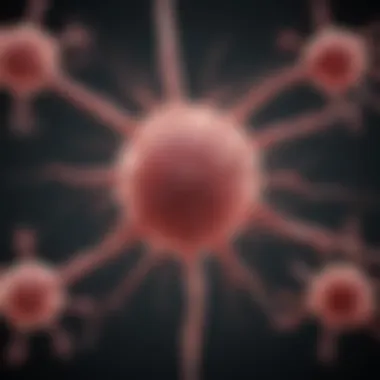Exploring Blood Cancer and Sexual Transmission Risks


Intro
Blood cancer, also known as hematologic cancer, encompasses a range of malignancies affecting the blood, bone marrow, and lymphatic system. The most common types include leukemia, lymphoma, and multiple myeloma. Despite its prevalence, the pathways through which blood cancer develops often remain poorly understood, particularly regarding the relationship between blood cancer and sexual transmission. This article seeks to dissect that relationship, clarify common misconceptions, and provide insights into existing research on this topic.
Background and Context
Overview of the Research Topic
The potential association between blood cancer and sexually transmitted infections (STIs) is a field that has garnered attention in recent years. While most cancers are generally not thought to be transmitted through sexual contact, certain infectious agents have been shown to increase the risk of certain types of malignancy, creating interest in understanding more about these connections. For instance, some viral infections, such as Human Immunodeficiency Virus (HIV) and Human Papillomavirus (HPV), are known to be transmitted sexually and have been linked to various cancers.
Historical Significance
Historically, the understanding of cancer as a disease often excluded considerations of sexual transmission. However, as the medical community has uncovered more about the viral origins of some cancers, the conversation has shifted. This realization is pivotal, especially in the case of blood cancers, where the role of infections and other risk factors in carcinogenesis is becoming clearer. Research dating back to the late 20th century began to elucidate how certain viruses associated with STIs can influence the immune system and lead to an increased risk of cancer.
Key Findings and Discussion
Major Results of the Study
Recent studies have begun to investigate how persistent infections can lead to changes in the immune environment, which may pave the way for cancer development. For example, recent research indicates that patients with HIV are at an increased risk for lymphomas and other blood cancers due to the virus's impact on the immune system. On the other hand, although HPV is primarily associated with cervical cancer, some studies suggest that it may also have implications for other cancer types, warranting further investigation.
Detailed Analysis of Findings
Several key factors emerge when discussing the intersection of blood cancer and sexual transmission:
- Infectious Agents: The role of HIV and HPV as infectious agents must be emphasized. These viruses directly impact cellular mechanisms and immune response, contributing to cancer risk.
- Immune System Suppression: Chronic infections can lead to immunosuppression, facilitating the development of various malignancies, including blood cancers.
- Transmission Dynamics: Understanding the dynamics of transmission can help define potential preventive measures. Awareness is crucial to limit exposure to such viruses, ultimately reducing the risk of associated cancers.
"Preventive measures against STIs not only protect sexual health but may also play a significant role in reducing cancer risks."
Overall, the intricate relationship between blood cancers and sexual transmission is multifaceted and continuously evolving as research advances. A robust understanding of this relationship can promote both individual and community health, especially in high-risk populations.
Understanding Blood Cancer
Understanding blood cancer is crucial in contexts surrounding sexual transmission. Blood cancer refers to malignancies that affect the blood, bone marrow, and lymphatic system. This understanding helps differentiate the types of blood cancers and their unique characteristics, which is essential for exploring any potential relationship between these cancers and sexually transmitted infections.
Types of Blood Cancer
Leukemia
Leukemia includes cancers of the blood-forming tissues, primarily affecting the bone marrow. One key aspect is that it can present in either acute or chronic forms. This variety contributes to our overall inquiry by showing how blood cancer might be influenced by infectious agents like HPV or HIV. Its common characteristics include rapid proliferation of abnormal blood cells, leading to frequent infections, anemia, and bleeding issues. Understanding the unique feature of leukemia's varied presentation assists in recognizing potential risk factors during research.
Lymphoma
Lymphoma arises from lymphocytes and is a crucial area in the study of blood cancer. It is categorized as either Hodgkin's or Non-Hodgkin's lymphoma. This classification is significant as it influences prognosis and treatment. Lymphoma can sometimes be linked with viral infections like Epstein-Barr virus. The tendency to manifest in affected lymph nodes and the immune system makes it a relevant cancer type in this article because it illustrates the immune response connected to sexual transmission.
Myeloma
Myeloma, specifically multiple myeloma, is a cancer of plasma cells in the bone marrow. This cancer is noteworthy for its relationship with the immune response. Its study is beneficial as it helps connect immune dysregulation and infectious agents. The unique feature of myeloma’s development from abnormal plasma cells is crucial for understanding the complexity of blood cancers. The impact on immunity and subsequent infections reinforces the need for research into potential links with sexually transmitted infections, since many patients become immunocompromised.
Symptoms and Diagnosis
Common Symptoms
The common symptoms associated with blood cancer, such as fatigue, fevers, and frequent infections, are essential to understand as they may inform how infections influence the disease's progress. Recognizing these symptoms can impact early detection strategies. The wide array of symptoms represented in blood cancers is beneficial because it shows how systemic involvement can often mask the underlying condition. This emphasizes the importance of awareness among both patients and healthcare providers in connection to potential sexual health risks.
Diagnostic Tests
Diagnostic tests are a fundamental part in the investigation of blood cancers. Tests such as blood counts, bone marrow biopsies, and imaging studies are crucial for accurate diagnosis. The key characteristic of these tests is that they enable clinicians to differentiate between various types of blood cancers effectively. They help ascertain the presence of cancerous cells and determine their impact on blood function. A thorough understanding of these tests provides clarity on the disease's stage and overall health effects, which is fundamental for effective management.
Staging of Blood Cancer
Staging of blood cancer is the process of determining the extent of the disease in the body. This is an essential aspect of blood cancer management as it influences treatment decisions. The key characteristic of staging is that it helps to predict prognosis and guide therapy. The unique feature of staging is its reliance on specific criteria, such as cell type and extent of involvement, which could also reflect vulnerabilities in the context of infections. Gaining insights into how blood cancer staging interacts with the body's overall health can provide essential discussions regarding potential risks associated with sexually transmitted infections.
Mechanisms of Cancer Development
The mechanisms of cancer development are central to understanding the potential links between blood cancer and sexual transmission. This section will explore how genetic and environmental factors contribute to the onset of blood cancer. By analyzing these mechanisms, we can evaluate the relationship between sexually transmitted infections and cancer risks. Here, we focus on genetic predispositions, environmental exposures, and their implications for research and public health.


Genetic Factors
Mutations and Cancer
Mutations are changes in the DNA sequence that can lead to cancer development. The study of mutations is crucial because certain mutations can directly contribute to the progression of blood cancer. For instance, mutations in genes such as TP53 and KRAS are often observed in various types of cancers, including blood cancers. Understanding these mutations allows for targeted therapies and helps identify at-risk populations.
The key characteristic of mutations is their ability to alter cellular processes, leading to uncontrolled cell growth. This feature makes the topic of mutations particularly important for this article. Furthermore, distinct mutations might indicate a genetic predisposition to certain cancers, prompting early interventions and lifestyle modifications.
A unique aspect of mutations is their variability among individuals. Not everyone exposed to similar risk factors will develop cancer, highlighting the need for personalized approaches in treatment and prevention. Nevertheless, the challenge lies in figuring out how to effectively screen for these mutations in the general population.
Hereditary Factors
Hereditary factors play a significant role in cancer development, as certain cancers can run in families. This aspect of hereditary influences is essential for our article since understanding familial patterns can help identify individuals at increased risk of blood cancer.
The primary characteristic of hereditary factors is their genetic component. When a family member is diagnosed with blood cancer, it might indicate that others in the family could be at risk. This possibility should motivate regular health screenings for those with a family history of blood cancer.
An important feature of hereditary factors is that genetic predisposition does not guarantee cancer development; rather, it shows susceptibility. This can be both an advantage and a disadvantage. It offers insights for proactive health management but can also lead to anxiety among those who fear genetic risks. Researchers currently focus on identifying specific gene variations that contribute to blood cancers.
Environmental Influences
Exposure to Carcinogens
Exposure to carcinogens is a critical aspect in understanding blood cancer development. Carcinogens, substances that promote cancer formation, can arise from various environmental sources such as pollution, tobacco smoke, and certain chemicals.
The significance of this exposure lies in its direct correlation with increased cancer risk. For example, prolonged exposure to benzene, commonly found in industrial emissions, has been linked to blood cancers like leukemia. Documenting such exposures is essential for public health applications.
A unique feature of exposure to carcinogens is its preventability. Governments and organizations can implement stricter regulations to limit exposure, thereby reducing risk factors associated with blood cancer. However, the challenge persists in ensuring public compliance and awareness as well as addressing variables like socioeconomic status, which can influence susceptibility.
Radiation and Chemicals
Radiation and chemical exposures are paramount in discussing mechanisms leading to blood cancer. Ionizing radiation, such as from X-rays or nuclear fallout, has a well-established link to various cancers, including leukemia.
The key characteristic of radiation is its ability to damage DNA directly, which can result in mutations and consequential cancer development. The impact of chemicals, such as those used in chemotherapy, can also lead to secondary cancers, underscoring the importance of monitoring cumulative exposure over time.
A defining feature of studying radiation and chemicals is the ongoing research into their long-term health consequences. While research continues to elucidate these connections, it is equally vital to develop safety guidelines to protect vulnerable populations.
By understanding both genetic and environmental influences, we gain comprehensive insights into the mechanisms of cancer development, which forms the basis for further study on the relation between blood cancer and sexual transmission.
Sexual Transmission of Infections
The exploration of sexual transmission of infections is critical in understanding the potential links to blood cancer. The evidence suggests that certain sexually transmitted infections (STIs) have the potential to act as risk factors for various malignancies. Recognizing the patterns and implications of STI transmission not only aids in public health strategies but also informs clinical practices regarding prevention and early detection.
Common Sexually Transmitted Infections (STIs)
HIV and Its Implications
Human Immunodeficiency Virus, or HIV, stands out due to its profound impact on the immune system. Those infected are at a heightened risk for various cancers, including certain blood cancers. This correlation arises because HIV impairs immune function, which reduces the body’s ability to combat cancerous cells.
The ability of HIV to facilitate oncogenic processes makes it a focal point in cancer research. The unique feature of HIV is its role as an immunosuppressant, influencing the entire body, thus potentially leading to multiple malignancies. This characteristic is particularly relevant in blood cancers, where immune responsiveness is critical.
Human Papillomavirus (HPV)
Human Papillomavirus (HPV) is well-known for its association with cervical cancer, but its implications extend to other malignancies, including some types of blood cancer. HPV has many strains, of which a few are recognized as oncogenic. The viral integration into host DNA can lead to mutations that predispose cells to malignant transformation.
A key characteristic of HPV is its widespread prevalence and the asymptomatic nature of most infections, making it challenging to control its spread. The implication of HPV in blood cancers serves as a reminder of the need for ongoing research to clarify its role and potential modes of action.
Hepatitis Viruses
Hepatitis viruses, particularly Hepatitis B and C, are significant due to their chronic infection potential and association with liver cancer. However, recent research has begun to investigate their impact on blood cancers. Chronic inflammation caused by these viral infections can lead to genetic mutations, creating an environment where cancer may develop.
A noteworthy characteristic of Hepatitis viruses is their ability to be transmitted through sexual contact as well as through blood. This dual transmission route underscores their relevance in discussions regarding STIs and cancer risk. The chronic nature of these infections further emphasizes the need for diligent monitoring and intervention, potentially impacting blood cancer development.
Mechanisms of Transmission
Direct Contact
Direct contact remains one of the primary means of transmitting many STIs. This includes sexual intercourse, where bodily fluids can exchange. Understanding the mechanism is crucial in evaluating how STIs contribute to subsequent cancer cases.


The key characteristic of direct contact transmission is its simplicity yet effectiveness. It highlights the importance of preventative measures, as such interactions can lead to immediate exposure without any visible symptoms. This aspect makes education on safe practices paramount in reducing STI incidences and their associated risks.
Bloodborne Transmission
Bloodborne transmission is another significant route, particularly relevant in the context of certain infections like HIV and Hepatitis. These pathogens can be present in blood, making practices such as shared needles especially risky. This mode of transmission reinforces the importance of blood safety in health care practices and among high-risk populations.
The unique feature of bloodborne transmission lies in its potential for rapidity in virus dissemination. It allows infections to spread without the need for sexual activity, which complicates the public health messaging surrounding STI prevention. It emphasizes the necessity for targeted strategies to curb the spread of infections that have broader implications for cancer development.
Link Between Infections and Cancer
The relationship between infections and cancer, particularly blood cancer, is significant for understanding both conditions. Many studies highlight the role that certain infections play in the progression or development of various cancers. This section delves into how sexually transmitted infections (STIs) may contribute to oncogenic pathways, providing clarity on this complex relationship.
The Oncogenic Potential of STIs
Cervical Cancer and HPV
Human Papillomavirus (HPV) is well-known for its contribution to cervical cancer. A key characteristic of HPV is its ability to integrate genetic material into host cells, leading to dysregulation of normal cellular processes. This factor contributes significantly to the overall understanding of cancer and its links to infections. Particularly for this article, emphasizing the mechanism by which HPV causes cervical cancer can provide insights into potential preventive measures, such as vaccination. A unique feature of this relationship is the fact that HPV is a preventable infection through vaccination, thus showcasing the importance of educational initiatives aimed at reducing transmission rates. However, the challenge remains in the acceptance and uptake of the vaccine.
Kaposi Sarcoma and HIV
Kaposi Sarcoma is another example linking infections and cancer, particularly associated with HIV infection. The unique aspect of Kaposi Sarcoma is its chronic association with immunosuppression that occurs due to HIV. This creates a conducive environment for cancer development. The role of HIV as a key characteristic in the progression of Kaposi Sarcoma highlights the intersection between infectious diseases and malignancies. In this article, discussing Kaposi Sarcoma provides a deeper understanding of how the journey from infection to cancer can take place. On the downside, while there are treatments available for HIV, the stigma surrounding the disease can hinder access to care and education, which are crucial for prevention.
Understanding Blood Cancer Etiology
Possible Links to Infections
The exploration of possible links to infections concerning blood cancer is vital. Various studies suggest that infections might play a role in the etiology of blood cancers like Leukemia and Lymphoma. A crucial aspect of this topic is understanding how chronic infections may lead to genetic mutations or alterations, paving the way for cancer. This makes it relevant for public health discussions, especially around preventive measures and awareness campaigns. The unique feature of this research is its potential to uncover modifiable risk factors associated with blood cancer. However, the challenge lies in establishing direct causation, as many factors interplay in cancer development, complicating this exploration.
Current Research Insights
Current research into the links between infections and blood cancer is evolving. Studies are increasingly focused on understanding underlying mechanisms. A key characteristic of these insights is the interdisciplinary approach used, involving genetics, microbiology, and epidemiology. This helps paint a comprehensive picture of how infections may influence blood cancer development. For this article, providing current insights is beneficial for guiding future research directions and public health strategies. Unique features of this ongoing research include novel biomarkers being identified. Nonetheless, funding constraints and the complexity of cancer make it a challenging area of study, often leading to gaps in long-term findings.
Understanding these links can be vital for innovative preventive strategies and improving public health coordination related to blood cancer.
This section serves to bridge existing knowledge gaps while spotlighting essential findings regarding the relationship between infections and cancer. As research progresses, the hope is to shape better health policy and practices that can reduce the incidence of blood cancers associated with infectious diseases.
Research Findings and Perspectives
The exploration of blood cancer in relation to sexual transmission requires a thorough examination of existing research findings. Understanding how blood cancer may be influenced by various factors is crucial. This section breaks down key epidemiological studies and identifies gaps in current research, providing insights that are vital to both medical communities and public health understanding.
Epidemiological Studies
Case-Control Studies
Case-control studies play an essential role in epidemiological research. They compare individuals with a specific condition, such as blood cancer, to those without it. This design allows researchers to identify potential factors that may contribute to the development of the disease. One key characteristic of case-control studies is their retrospective approach, examining past exposures that could lead to blood cancer. This method is beneficial for our article as it highlights potential links between infections and cancer development without needing extensive time for data collection.
However, there are disadvantages, including the potential for recall bias. Participants may not accurately remember their past sexual history or exposure to sexually transmitted infections, which can distort the findings. Despite this limitation, the unique feature of case-control studies lies in their ability to quickly generate hypotheses for further research.
Cohort Studies
Cohort studies offer another significant avenue for research, examining a group of individuals over time. In contrast to case-control studies, cohort studies are prospective, starting with a healthy population and observing outcomes as they occur. This design is particularly valuable because it tracks real-time data related to blood cancer incidence and associated risk factors. Cohort studies can effectively establish temporal relationships, benefiting the overarching goal of our article by clarifying the timeline between infection and disease development.
Despite their strengths, cohort studies can be resource-intensive and time-consuming. They require large sample sizes and long follow-up periods, which can present logistical challenges. However, the unique advantage of this method is its ability to provide strong evidence regarding causal relationships.
Research Gaps and Future Directions
Need for Longitudinal Studies
The necessity for longitudinal studies is evident in the context of blood cancer and sexual transmission. Such studies observe the same subjects over time, allowing researchers to capture changes and developments comprehensively. The key characteristic of longitudinal studies is their ability to identify trends and long-term effects, which is often lacking in cross-sectional designs. This aspect is essential for our article, as it can help clarify causal pathways linking sexual health and blood cancer.
The main advantage of longitudinal studies is the quality of data they produce. They significantly reduce biases associated with recall and selection, providing a clearer picture of health outcomes. However, they also require significant resources and commitment from both researchers and participants.
Understanding Mechanisms
Understanding mechanisms by which sexually transmitted infections could lead to blood cancer is a critical area of future research. This understanding is essential for establishing the biological links between infections and oncogenesis. The ability to elucidate these mechanisms is a key characteristic that enhances our article's depth, offering insights into how certain infections might contribute to blood cancer development over time.
The unique feature of this research area is its focus on genetic, immunologic, and molecular factors. By investigating how STIs can change cellular processes, researchers can identify specific targets for prevention and treatment. Nevertheless, this field faces challenges, including the complexity of biological interactions and the need for advanced technology.


"Clarifying the relationship between cancer development and infections is vital for informed public health strategies and personal health decisions."
By addressing these gaps and advocating for robust research methodologies, we pave the way for future studies that can illuminate the intricate ties between sexual transmission and blood cancer.
Public Perception and Misconceptions
The relationship between blood cancer and sexual transmission involves complex interconnections often clouded by myths and misunderstandings. Public perception plays a critical role in shaping attitudes towards health issues, particularly when it involves sensitive topics such as cancer and its potential transmission routes. Addressing misconceptions not only enlightens the public about the true risks but also helps foster a more informed discourse among patients, caregivers, and medical professionals.
A key consideration in this context is education. Misunderstandings can lead to stigmatization of patients or avoidance of necessary screenings. Thus, debunking myths contributes significantly to public health by encouraging informed decisions about sexual health, cancer screening, and general wellbeing.
Myths About Blood Cancer Transmission
Sexual Activity and Cancer Risk
Many people mistakenly believe that sexual activity can directly cause blood cancers. This belief centers on the assumption that infections contracted through sexual means could lead to blood cancer development. However, current scientific evidence does not support direct causation. While some sexually transmitted infections (STIs) are linked to certain cancers, notably cervical cancer due to HPV, the connection to blood cancers such as leukemia or lymphoma is not established.
The significant misconception lies in the misunderstanding of how cancer develops. Sexual Activity and Cancer Risk as a topic emphasizes the need for clarity about risks associated with sexual behaviors. Highlighting these myths can help reduce unnecessary fear and stigma associated with sexual health and overall cancer risks. Understanding that sexual activity does not inherently lead to blood cancers helps individuals focus on real risk factors instead.
Clarifying Misinformation
In addressing Clarifying Misinformation, it is vital to consider the role of reliable information in combating myths. Misinformation surrounding blood cancers often stems from limited knowledge about cancer transmission routes and mechanisms. This aspect has a profound impact on public understanding.
The unique feature of clarifying misinformation is its potential to alter perspectives. When individuals are presented with accurate data, it can change their beliefs and behaviors regarding health. This process is beneficial in creating an environment where individuals feel empowered to seek appropriate tests and screenings. As misconceptions dissolve, it paves the way for more profound discussions about sexual health and cancer prevention.
Educational Efforts and Their Importance
Health Awareness Campaigns
Health Awareness Campaigns aim to promote knowledge regarding cancer risks through targeted messaging. Such campaigns are crucial for bridging gaps in understanding how different health factors may interact. They facilitate communication about blood cancer, its risk factors, and preventive measures effectively.
These campaigns often include workshops, informational pamphlets, and online content engaging a wider audience. The unique feature of such efforts is their ability to reach diverse demographic groups, tailoring messages to various audiences. As a result, they create a more informed community equipped to make educated health choices.
Role of Healthcare Providers
The Role of Healthcare Providers is indispensable in dispelling myths and providing accurate information. Healthcare professionals are often the primary source of information for patients and can offer clarity regarding cancer risks associated with sexual behaviors. When providers openly discuss potential risks and preventive measures, they cultivate trust.
The unique aspect of this role is its direct impact on patient education. By prioritizing transparent communication, healthcare providers can address concerns and guide patients through necessary testing and prevention strategies. This effort can lead to increased healthcare uptake and reduced stigmatization of blood cancer patients.
Understanding the intricate relationships between sexual health and cancer risk does not only enhance individual health choices but fosters a more informed society as a whole.
Communication aimed at informational clarity has the power to influence public perception, transforming myths into facts. It is imperative for future public health endeavors.
Ending and Implications
The relationship between blood cancer and sexual transmission opens up complex discussions that are often misunderstood. This article emphasizes the importance of understanding this connection for both the public and healthcare providers. Through analyzing data, this article aims to provide clarity around the myths regarding blood cancer risks. The implications are significant, highlighting the need for an informed public that can discern fact from fiction, especially regarding sexual health and cancer risks.
Additionally, it demonstrates how a deeper understanding of sexually transmitted infections (STIs) can alter perceptions. An informed approach can empower individuals to take proactive measures regarding their health. In this regard, awareness is crucial in addressing and mitigating potential risks associated with blood cancer.
Summary of Key Findings
Multiple strands of evidence have led to the conclusion that while blood cancer itself is not primarily transmitted through sexual activity, some STIs that are sexually transmitted can pose risks for cancer development. Key findings include:
- Certain infections, such as HIV, have been linked to types of blood cancer.
- Understanding these relationships can help with prevention strategies.
- Educational campaigns are needed to eliminate myths surrounding blood cancer transmission.
This summary serves as a basis for informed discussions and decision-making in health policies and personal health management.
Recommendations for Public Health
Importance of Testing
Testing has a pivotal role in identifying infections that could lead to blood cancer. Regular screenings for STIs can pay off in early detection, allowing for timely intervention. By encouraging testing, we can address health risks more efficiently. The key characteristic of the importance of testing is its role in providing peace of mind. Being proactive empowers individuals with knowledge about their health status.
Unique Feature of Importance of Testing
One distinct advantage of regular testing is the ability to catch asymptomatic infections before they lead to more serious conditions, including cancers. It creates a pathway for educational outreach, promoting awareness and understanding among the population regarding the importance of timely health checks.
Vaccination and Preventative Measures
Vaccination programs, particularly for viruses such as HPV and hepatitis, show promise in reducing cancer risks. These preventative measures significantly contribute to the overall goal of reducing the incidence of blood cancer related to STIs. Their key characteristic is that they offer an avenue for long-term protection.
Unique Feature of Vaccination and Preventative Measures
One unique feature of vaccination is its proactive approach, addressing infections before they can result in further health complications. While there may be challenges in vaccination uptake, the advantages often outweigh potential disadvantages. High public health risk models advocate for widespread vaccination, which can greatly assist in reducing cancer rates linked to viral infections.







